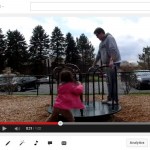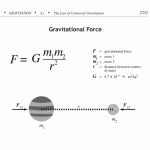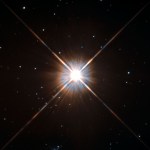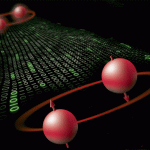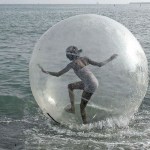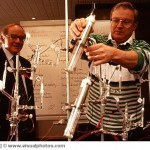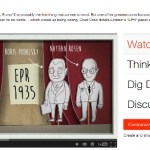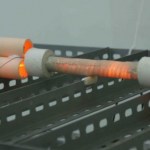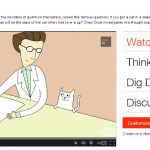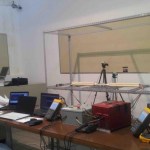Physics
I'm teaching relativity in a course with an astronomy prefix, which means I'm obliged to talk about stars and stuff. Yesterday's lecture was about neutron stars, and how their existence was confirmed by the discovery of pulsars (with the story of Jocelyn Bell Burnell included). This requires some discussion of angular momentum to explain how something that big ends up spinning that fast (cribbing a bit from these online notes), so I needed a good demonstration of angular momentum. Which is when I remembered this 2013 post with SteelyKid on the playground, where I estimated the mass of the…
“It is possible to commit no mistakes and still lose. That is not a weakness. That is life.” -Jean-Luc Picard
We like to think of nature as beautiful, elegant and infallible. Yet our notions of what's beautiful and elegant don't always line up with what reality gives us. Take the notion of symmetry, for example: the gravitational force is symmetric, always exerting equal magnitude forces on whatever two masses it occurs between.
WikiPremed MCAT Course, via http://www.wikipremed.com/01physicscards.php.
But as similar as they are, electricity and magnetism are not symmetric at all.…
If you wanted to travel to the stars -- and by that, I mean star systems beyond our own -- you'd better be prepared to take your sweet time. Even at the speeds the Apollo astronauts traveled to the Moon, it would take millions of years to reach even the next nearest star beyond our own, Proxima Centauri.
Image credit: ESA/Hubble & NASA, via http://www.spacetelescope.org/images/potw1343a/.
And yet, General Relativity admits an astounding possibility to short-cut the great cosmic distances by punching a hole in spacetime, connecting two far-separated events to one another…
A fine if somewhat intermittent tradition hereabouts has been the offering of high-concept Halloween costumes for people interested in physics, surfacing in 2010, 2012, and 2013. I'm a little too fried right now to do anything all that deep, but I'll try to offer a few suggestions; see also these particle-physics suggestions from Symmetry magazine, who have an art staff to make animated GIFs of their ideas.
Sexy Tycho Brahe: Ruffled collar, magnificent mustache, a little gold paint on your nose. Critically important that you remember to go to the bathroom beforehand, though-- it's going to be…
Wandering into the woods unprepared and without a plan sounds like a terrible idea. But if you're interested in scientific exploration at the frontiers, confronting the unknown with whatever you happen to have at your disposal, you have to take that risk. You have to be willing to take those steps. And you have to be okay with putting your best ideas out there -- for all to see -- knowing full well that you might get the entire thing wrong.
Image Credit: Arthur Eddington, Fundamental Theory.
Sometimes, that's indeed what happens. Some of the most revered and famous scientific minds in…
As mentioned last week, I was the on-hand expert for the Secret Science Club's foray into Massachusetts, a screening of the movie Particle Fever held at MASS MoCA. This worked out nicely in a lot of respects-- it gave me an excuse to visit the newly renovated Clark Art Institute in Williamstown and check out the spiffy new library at Williams (where they have my second book on the shelves, but not my first; I may need to send them an author copy in lieu of a check this year...). I also did some random nostalgia things like grabbing dinner at Colonial Pizza (now in a strip mall halfway to…
You've no doubt heard of quantum entanglement before: the idea that if you create a mixed quantum state that consists of two particles, you can then know the properties of one by measuring the properties of the other. The odd -- and counterintuitive -- thing about this is that once these particles are entangled, you can move them an arbitrary distance apart from one another, measure the properties of one, and instantly know about the properties of the other!
Image credit: John Jost / Jason Amini.
Does this violate the law of special relativity, which says the speed limit of everything…
I got the time for the regular hangout wrong, and then we had some weird computer difficulties, so we only had ten minutes for Uncertain Dots this week. Which was enough time for me to say disparaging things about comic book movies, so, you know, if that interests you...
Here's the making of Interstellar story about Kip Thorne.
Here's the Avengers 2 trailer.
Also, a program note: I will be at MASS MoCA tonight talking about Particle Fever, if you'd like to hear me talk about real physics on film, or just take issue with my slagging off comic-book movies in person...
Over at Backreaction, Bee has a nice piece on our current age of virality. Toward the end, she discusses some of the ways this applies to science, specifically a quote from this Nature article about collaborative efforts to measure "big G", and a story about a Chinese initiative to encourage collaboration. She writes of the latter, "Essentially, it seems, they’re giving out salary increases for scientists to think the same as their colleagues."
And I agree that this can be a problem-- there's a famous paper I can never find looking at the evolution of the accepted value of some physical…
“The anthropic principle – the idea that our universe has the properties it does because we are here to say so and that if it were any different, we wouldn’t be around commenting on it – infuriates many physicists, including [Marc Davis from UC Berkeley]. It smacks of defeatism, as if we were acknowledging that we could not explain the universe from first principles. It also appears unscientific. For how do you verify the multiverse? Moreover, the anthropic principle is a tautology. “I think this explanation is ridiculous. Anthropic principle… bah,” said Davis. “I’m hoping they are wrong […
That's "Mass" as in Massachusetts, not the stuff associated with the Higgs field... specifically, North Adams, MA, where I'll be this Saturday night, October 25th, at the Secret Science Club screening of Particle Fever. This will be at the MASS MoCA, tickets here.
The Secret Science Club is a regular gathering in New York City featuring mind-bending lectures, volatile experiments, and thematic chemical libations (special cocktails, that is). It’s like the coolest science class you’ve ever been to, but with drinks and a DJ. SSC rockets into MASS MoCA with a special screening of Particle Fever…
In odd-numbered years (by the Gregorian calendar, anyway), the University of Toronto offers the John Stewart Bell Prize for Research on Fundamental Issues in Quantum Mechanics and Their Applications. This is not connected to the Jon Stewart of the Daily Show-- he's purely classical, as you can tell from the fact that there's no "h" in his name. It honors the great Irish physicist John Bell, whose theorem showing that quantum models could be experimentally distinguished from local hidden variable theories helped kick off the thriving field of quantum information. (Bell's contribution is a big…
“Between cold fusion and respectable science there is virtually no communication at all. …because the Cold-Fusioners see themselves as a community under siege, there is little internal criticism. Experiments and theories tend to be accepted at face value, for fear of providing even more fuel for external critics, if anyone outside the group was bothering to listen. In these circumstances, crackpots flourish, making matters worse for those who believe that there is serious science going on here.” -David Goodstein
So, you want to reach the fabled "breakeven" point when it comes to nuclear…
The fourth video I wrote for TED-Ed is now live: Einstein's Brilliant Mistake: Entangled States. The title is not just an Elvis Costello reference, but gets at the fact that while the Einstein, Podolsky, and Rosen paper was wrong in that the local hidden variable theories they favored are impossible, it turned out to be important and productive.
As with the others, I'm very happy with the way this came out. The images are great, and I'm glad to get in the point that Bell's key insight involves measuring different properties for the two particles, which is sometimes glossed over. It was…
I enjoyed Caleb Scharf's previous book, Gravity's Engines a good deal, so I was happy to get email from a publicist offering me his latest. I'm a little afraid that my extreme distraction of late hasn't really treated it fairly, but then again, the fact that I finished it at all in my current state of frazzlement may be the best testament I can offer to its quality. This is a sweeping survey of what we've learned about our place in the universe over the last five hundred years or so.
Now, a grandiose description like that often portends a bunch of wifty philosophizing that poses grand…
“There’s a mark born every minute, and one to trim ‘em and one to knock ‘em.” -David W. Maurer, The Big Con (1940)
But how could you tell? There's lots of amazing science going on out there, and none of us can be experts in it all. Moreover, even when we think we know how things ought to behave, nature has a way of surprising us, and that's usually via experiment, which is our first indication that our theories are incomplete.
Image credit: CERN, via http://home.web.cern.ch/students-educators/updates/2013/04/find-higgs-b….
So what do we do when a new experimental result comes out,…
The third of the videos I wrote for TED-Ed is now live: Schrödinger's Cat: A Thought Experiment in Quantum Mechanics.This is using basically the same argument I outlined in this post, but with awesome animation courtesy of Agota Vegso. I'm impressed by how close the images that ended up in the video are to the pictures I had in my mind while I was writing it.
As I said in that old post, I dithered for a bit about whether to run with this argument, but decided I liked it enough to go ahead. You can legitimately quibble about some of the phrasing being a little too definite (or that Schrödinger…
It's baseball playoff time, so sport shows are full of one of the great mysteries of the season, exemplified by this .gif (from SBNation):
Raul Ibanez hitting a game-winning home run. GIF from SBNation.
No, not "Raul Ibanez, really?" but "How can he make the ball go that far?" After all, even very good outfielders are lucky to reach home plate with a throw from the warning track. Not even the hardest-throwing pitcher could stand at home plate and throw the ball into the second deck of a baseball stadium. Yet it's not uncommon for the ball to end up there after being hit by a bat. So, how…
A guy named Andrea Rossi has been promoting this device call the E-Cat that produces huge amounts of energy by nuclear fusion: specifically, that it fuses hydrogen and nickel to produce copper and energy. And now there is a claim that this amazing result has been verified, in a remarkably gushing and credulous review.
I am not a physicist, not even close. I am at best a moderately well-read layman. I also understand the general principles of fusion -- it's how stars work, it's how heavier elements have been built up over the history of the universe from lighter ones. I might be willing to…
If you like arbitrary numerical signifiers, this is the point where we can start to talk about plural dozens of Uncertain Dots hangouts. As usual, Rhett and I chat about a wide range of stuff, including the way we always say we're going to recruit a guest to join us, and then forget to do anything about that.
The video:
Other topics include how it's important to rip up your class notes every so often, the pros and cons of lab handouts/ lab manuals, and of course this week's Nobel Prize in Physics for blue LED's (shameless self-linkage).
I'm crushingly busy right now, largely because I had no…
